Oleksii Hrinchuk
Anticipating Future with Large Language Model for Simultaneous Machine Translation
Oct 29, 2024



Abstract:Simultaneous machine translation (SMT) takes streaming input utterances and incrementally produces target text. Existing SMT methods only use the partial utterance that has already arrived at the input and the generated hypothesis. Motivated by human interpreters' technique to forecast future words before hearing them, we propose $\textbf{T}$ranslation by $\textbf{A}$nticipating $\textbf{F}$uture (TAF), a method to improve translation quality while retraining low latency. Its core idea is to use a large language model (LLM) to predict future source words and opportunistically translate without introducing too much risk. We evaluate our TAF and multiple baselines of SMT on four language directions. Experiments show that TAF achieves the best translation quality-latency trade-off and outperforms the baselines by up to 5 BLEU points at the same latency (three words).
Chain-of-Thought Prompting for Speech Translation
Sep 17, 2024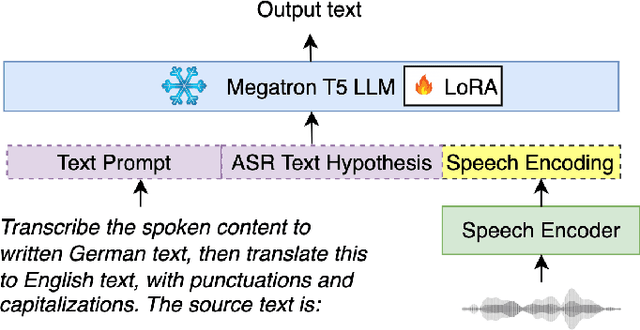
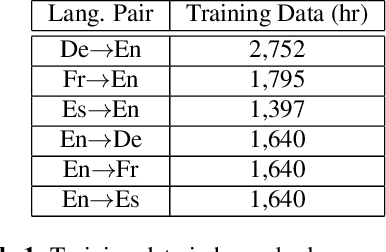
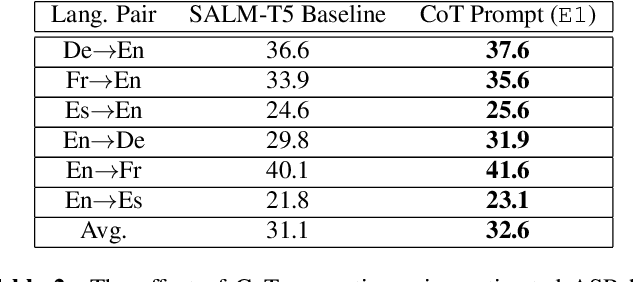
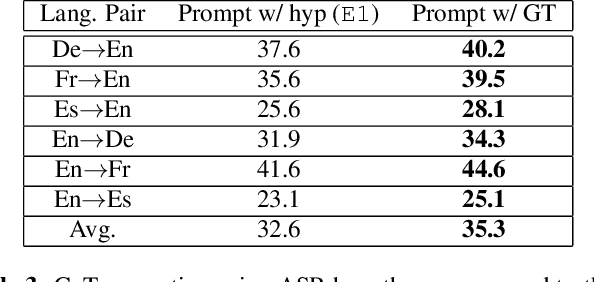
Abstract:Large language models (LLMs) have demonstrated remarkable advancements in language understanding and generation. Building on the success of text-based LLMs, recent research has adapted these models to use speech embeddings for prompting, resulting in Speech-LLM models that exhibit strong performance in automatic speech recognition (ASR) and automatic speech translation (AST). In this work, we propose a novel approach to leverage ASR transcripts as prompts for AST in a Speech-LLM built on an encoder-decoder text LLM. The Speech-LLM model consists of a speech encoder and an encoder-decoder structure Megatron-T5. By first decoding speech to generate ASR transcripts and subsequently using these transcripts along with encoded speech for prompting, we guide the speech translation in a two-step process like chain-of-thought (CoT) prompting. Low-rank adaptation (LoRA) is used for the T5 LLM for model adaptation and shows superior performance to full model fine-tuning. Experimental results show that the proposed CoT prompting significantly improves AST performance, achieving an average increase of 2.4 BLEU points across 6 En->X or X->En AST tasks compared to speech prompting alone. Additionally, compared to a related CoT prediction method that predicts a concatenated sequence of ASR and AST transcripts, our method performs better by an average of 2 BLEU points.
Longer is (Not Necessarily) Stronger: Punctuated Long-Sequence Training for Enhanced Speech Recognition and Translation
Sep 09, 2024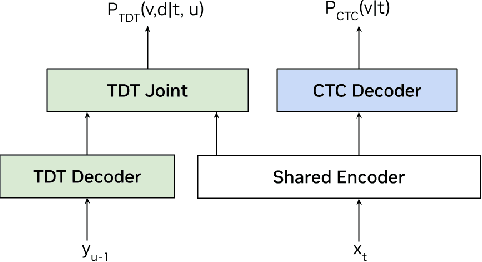

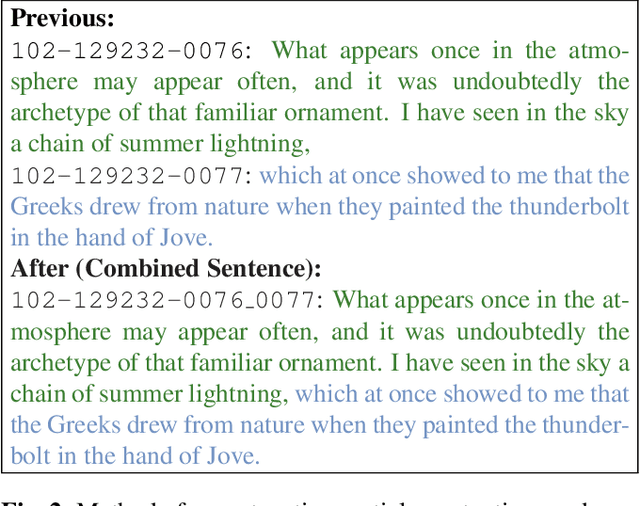

Abstract:This paper presents a new method for training sequence-to-sequence models for speech recognition and translation tasks. Instead of the traditional approach of training models on short segments containing only lowercase or partial punctuation and capitalization (PnC) sentences, we propose training on longer utterances that include complete sentences with proper punctuation and capitalization. We achieve this by using the FastConformer architecture which allows training 1 Billion parameter models with sequences up to 60 seconds long with full attention. However, while training with PnC enhances the overall performance, we observed that accuracy plateaus when training on sequences longer than 40 seconds across various evaluation settings. Our proposed method significantly improves punctuation and capitalization accuracy, showing a 25% relative word error rate (WER) improvement on the Earnings-21 and Earnings-22 benchmarks. Additionally, training on longer audio segments increases the overall model accuracy across speech recognition and translation benchmarks. The model weights and training code are open-sourced though NVIDIA NeMo.
Less is More: Accurate Speech Recognition & Translation without Web-Scale Data
Jun 28, 2024Abstract:Recent advances in speech recognition and translation rely on hundreds of thousands of hours of Internet speech data. We argue that state-of-the art accuracy can be reached without relying on web-scale data. Canary - multilingual ASR and speech translation model, outperforms current state-of-the-art models - Whisper, OWSM, and Seamless-M4T on English, French, Spanish, and German languages, while being trained on an order of magnitude less data than these models. Three key factors enables such data-efficient model: (1) a FastConformer-based attention encoder-decoder architecture (2) training on synthetic data generated with machine translation and (3) advanced training techniques: data-balancing, dynamic data blending, dynamic bucketing and noise-robust fine-tuning. The model, weights, and training code will be open-sourced.
BESTOW: Efficient and Streamable Speech Language Model with the Best of Two Worlds in GPT and T5
Jun 28, 2024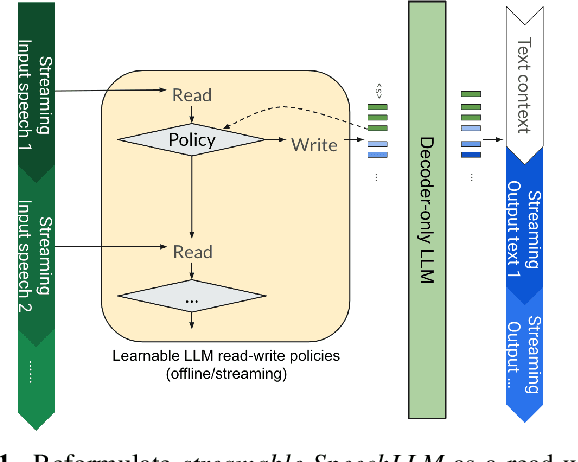

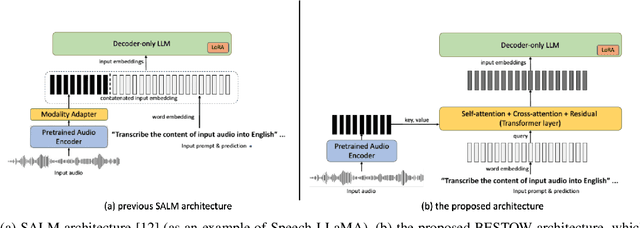

Abstract:Incorporating speech understanding capabilities into pretrained large-language models has become a vital research direction (SpeechLLM). The previous architectures can be categorized as: i) GPT-style, prepend speech prompts to the text prompts as a sequence of LLM inputs like a decoder-only model; ii) T5-style, introduce speech cross-attention to each layer of the pretrained LLMs. We propose BESTOW architecture to bring the BESt features from TwO Worlds into a single model that is highly efficient and has strong multitask capabilities. Moreover, there is no clear streaming solution for either style, especially considering the solution should generalize to speech multitask. We reformulate streamable SpeechLLM as a read-write policy problem and unifies the offline and streaming research with BESTOW architecture. Hence we demonstrate the first open-source SpeechLLM solution that enables Streaming and Multitask at scale (beyond ASR) at the same time. This streamable solution achieves very strong performance on a wide range of speech tasks (ASR, AST, SQA, unseen DynamicSuperb). It is end-to-end optimizable, with lower training/inference cost, and demonstrates LLM knowledge transferability to speech.
SALM: Speech-augmented Language Model with In-context Learning for Speech Recognition and Translation
Oct 13, 2023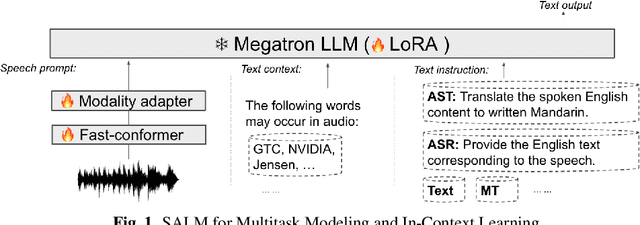
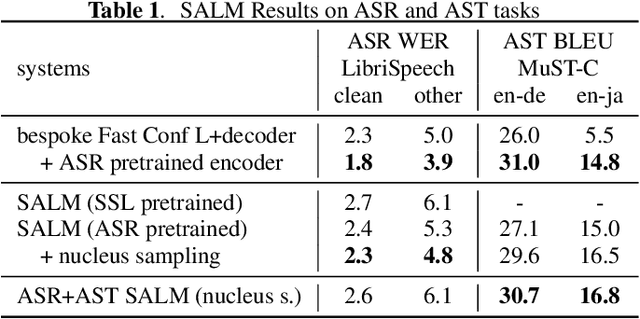
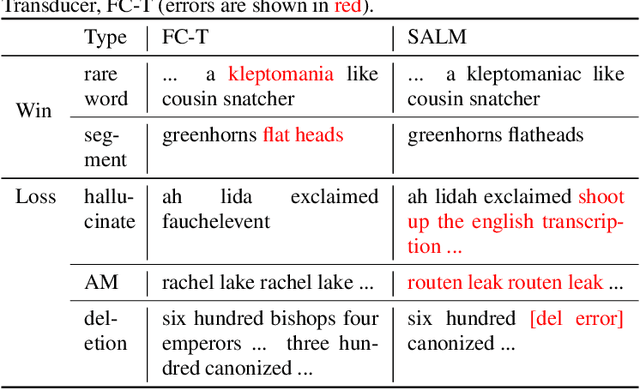

Abstract:We present a novel Speech Augmented Language Model (SALM) with {\em multitask} and {\em in-context} learning capabilities. SALM comprises a frozen text LLM, a audio encoder, a modality adapter module, and LoRA layers to accommodate speech input and associated task instructions. The unified SALM not only achieves performance on par with task-specific Conformer baselines for Automatic Speech Recognition (ASR) and Speech Translation (AST), but also exhibits zero-shot in-context learning capabilities, demonstrated through keyword-boosting task for ASR and AST. Moreover, {\em speech supervised in-context training} is proposed to bridge the gap between LLM training and downstream speech tasks, which further boosts the in-context learning ability of speech-to-text models. Proposed model is open-sourced via NeMo toolkit.
Fast Conformer with Linearly Scalable Attention for Efficient Speech Recognition
May 19, 2023



Abstract:Conformer-based models have become the most dominant end-to-end architecture for speech processing tasks. In this work, we propose a carefully redesigned Conformer with a new down-sampling schema. The proposed model, named Fast Conformer, is 2.8x faster than original Conformer, while preserving state-of-the-art accuracy on Automatic Speech Recognition benchmarks. Also we replace the original Conformer global attention with limited context attention post-training to enable transcription of an hour-long audio. We further improve long-form speech transcription by adding a global token. Fast Conformer combined with a Transformer decoder also outperforms the original Conformer in accuracy and in speed for Speech Translation and Spoken Language Understanding.
Leveraging Synthetic Targets for Machine Translation
May 07, 2023



Abstract:In this work, we provide a recipe for training machine translation models in a limited resource setting by leveraging synthetic target data generated using a large pre-trained model. We show that consistently across different benchmarks in bilingual, multilingual, and speech translation setups, training models on synthetic targets outperforms training on the actual ground-truth data. This performance gap grows bigger with increasing limits on the amount of available resources in the form of the size of the dataset and the number of parameters in the model. We also provide preliminary analysis into whether this boost in performance is linked to ease of optimization or more deterministic nature of the predictions, and whether this paradigm leads to better out-of-distribution performance across different testing domains.
Finding the Right Recipe for Low Resource Domain Adaptation in Neural Machine Translation
Jun 02, 2022
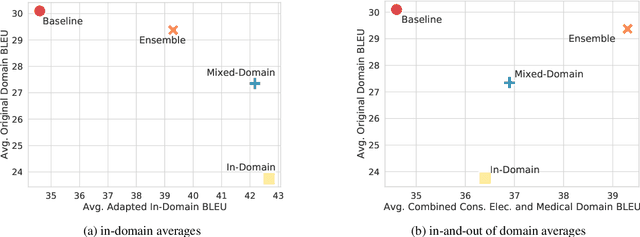
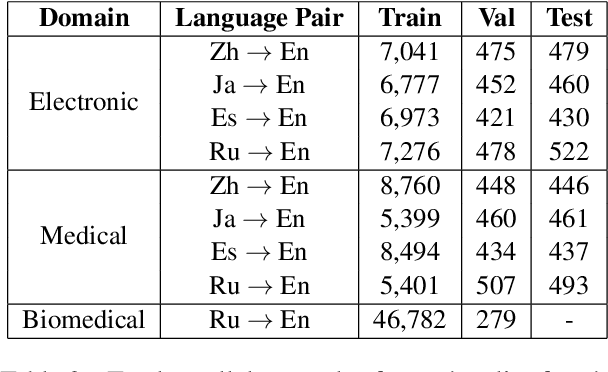

Abstract:General translation models often still struggle to generate accurate translations in specialized domains. To guide machine translation practitioners and characterize the effectiveness of domain adaptation methods under different data availability scenarios, we conduct an in-depth empirical exploration of monolingual and parallel data approaches to domain adaptation of pre-trained, third-party, NMT models in settings where architecture change is impractical. We compare data centric adaptation methods in isolation and combination. We study method effectiveness in very low resource (8k parallel examples) and moderately low resource (46k parallel examples) conditions and propose an ensemble approach to alleviate reductions in original domain translation quality. Our work includes three domains: consumer electronic, clinical, and biomedical and spans four language pairs - Zh-En, Ja-En, Es-En, and Ru-En. We also make concrete recommendations for achieving high in-domain performance and release our consumer electronic and medical domain datasets for all languages and make our code publicly available.
NVIDIA NeMo Neural Machine Translation Systems for English-German and English-Russian News and Biomedical Tasks at WMT21
Nov 16, 2021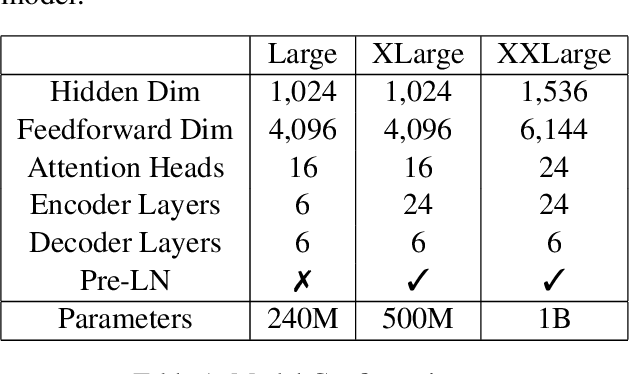
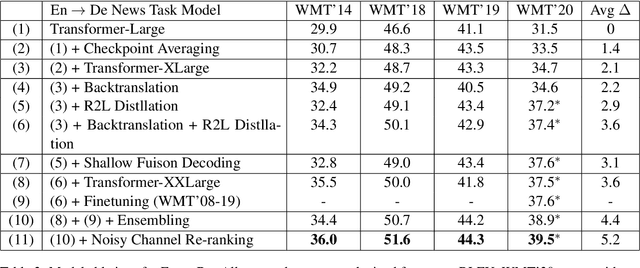


Abstract:This paper provides an overview of NVIDIA NeMo's neural machine translation systems for the constrained data track of the WMT21 News and Biomedical Shared Translation Tasks. Our news task submissions for English-German (En-De) and English-Russian (En-Ru) are built on top of a baseline transformer-based sequence-to-sequence model. Specifically, we use a combination of 1) checkpoint averaging 2) model scaling 3) data augmentation with backtranslation and knowledge distillation from right-to-left factorized models 4) finetuning on test sets from previous years 5) model ensembling 6) shallow fusion decoding with transformer language models and 7) noisy channel re-ranking. Additionally, our biomedical task submission for English-Russian uses a biomedically biased vocabulary and is trained from scratch on news task data, medically relevant text curated from the news task dataset, and biomedical data provided by the shared task. Our news system achieves a sacreBLEU score of 39.5 on the WMT'20 En-De test set outperforming the best submission from last year's task of 38.8. Our biomedical task Ru-En and En-Ru systems reach BLEU scores of 43.8 and 40.3 respectively on the WMT'20 Biomedical Task Test set, outperforming the previous year's best submissions.
 Add to Chrome
Add to Chrome Add to Firefox
Add to Firefox Add to Edge
Add to Edge